
CosMic Plants is using its state-of-the-art facilities to grow both young starter and finished plants
Potted orchids are continuing to increase in popularity across North America. USDA statistics show them to be second only to poinsettias in potted flowering plant sales in the United States, and they’re closing in fast. Consumers can’t seem to get enough of them. And some observers feel it’s only a matter of time before orchids take over the top spot, given the number of years of double-digit growth these premium potted performers have experienced since the mid-1990s. CosMic Plants of Beamsville, Ontario, has quickly become one of Canada’s leading phalaenopsis orchid specialists. This
combined propagation and finished plant operation is headed by brothers Neil and Mike van Steekelenburg.
“This may be the year potted orchids surpass poinsettias,” says Mike. “The poinsettia market has peaked. The market for phalaenopsis orchids is still growing.”
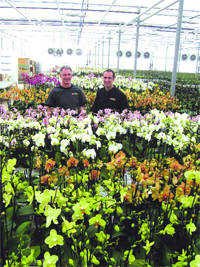 |
| Neil and Mike van Steekelenburg, owners of CosMic Plants in Beamsville, Ontario. |
The idea for the new venture was launched in 2001. At the time, Neil was running the family’s potted plant operation in the Netherlands and Mike was working with EuroFresh Farms in Arizona. The two thought it would be great to team up and start their own company, combining their extensive experience in production and marketing.
They initially considered several places, both in Holland and abroad, to set up shop. However, after visiting friends in Ontario they were convinced to further explore the Niagara region. After a few
visits, and a number of conversations with area growers and industry specialists, they soon concluded Niagara would, indeed, be an ideal location to launch their joint venture.
CosMic Plants took possession of this former potted plant operation in July of 2004, and the brothers then spent four months completely upgrading the facilities with a new irrigation system, new boilers, an automated potting machine, and the installation of double-curtains. They installed a three-phase electrical system to accommodate new grow lights and air conditioning units.
“It was a total renovation,” recalls Mike, while outlining the company’s history. Just about everything was replaced or upgraded. “We only kept the frame of the greenhouse.”
The greenhouse is now “as state of the art as it gets” for growing phalaenopsis orchids, Mike explains. This ensures premium plant quality, maximum production efficiency and minimal plant losses.
An internal transport movable benching system maximizes efficiencies. All the production work is done in the first greenhouse, with the benches moved throughout the other greenhouses as the plants develop. By the time they are at the shipping stage, they are back in the first greenhouse.
There are no peaks in their production calendar, just steady, year-round production. “The greenhouses are kept full every day of the year,” explains Mike. “There is very little loss of space efficiency.”
CosMic Plants has close ties with Sion, one of the world’s leading producers and propagators of phalaenopsis orchids, with head offices in the Netherlands. The two companies are working together to supply North American growers with rooted phalaenopsis young plants grown to the six-month stage.
This works well for those grower-customers because they’ll have lower heating costs, while at the same time CosMic Plants has assumed the risks for getting the plants started and well on their way toward the flowering stage. “The first six months coming out of the tissue culture lab is quite critical.”
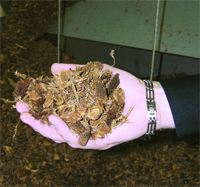 |
| Bark is a perfect growing medium. Deliveries are closely checked for consistency. |
Mike worked for Sion a few years ago to learn as much as he could about phalaenopsis orchids. “We also wanted to build a good relationship with them.”
He says Sion is highly regarded within the industry. “They have gone through an incredible growth phase over the past few years.”
This is not a crop for the faint-hearted, or those without patience. It takes 18 months before you have flowering plants ready for the market. “It’s a huge investment,” notes Mike. “This is such a long crop with a high investment in young plant material that you want to be sure you’re starting out with exceptional quality.”
With the finished plant component of its business, CosMic Plants grows only 5” pots, a popular European size (12 cm). The majority of the North American market had been growing either 4” or 6” pots. With the 5” pots, CosMic Plants can still produce double spikes and lots of flowers. This size also results in more efficient greenhouse spacing, and they can get more plants in a box.
Air conditioning is important during the crop’s cool phase. During the vegetative phase, the plants are grown at 27˚C. However, during the second phase during which flowering is initiated, they’re grown at 19˚C. Summer temperatures rising to the mid-30s˚C are not uncommon in the Niagara region. That’s where the air conditioning comes in. “We have to be sure that when it’s 35˚C outside that it’s still only 19˚C inside.”
The plants are grown in bark. That’s because in their natural habitat, the plants don’t require soil; they can grow quite easily on trees with their roots exposed. They are epyphytes and just need something to attach themselves to. The bark mixture, being light and airy and with great drainage, is the perfect medium. “Peat moss would be much too dense.”
One of the challenges for growers is to ensure consistency with the bark shipments. “We have to check each load to make sure it’s similar to what we’ve been used to growing in.”
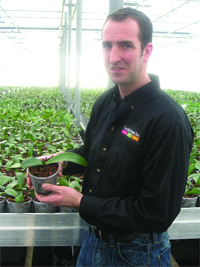 |
| Mike van Steekelenburg with a young plant. |
Phalaenopsis orchids are quite sensitive to light. CosMic Plants has a light meter at its outside weather station, along with two inside units. All measure in PAR (Photosynthetic Active Radiation), rather than in lux, to ensure optimal growing conditions specific to the needs of the crops.
The shading systems reduce sunlight when it’s too bright. “We have two curtains to give us more flexibility,” says Mike.
Their greenhouses are double-poly. Their preference would have been glass, but there was no way to retrofit the greenhouses accordingly. However, the double poly is working out well, with the added bonus of increased energy efficiency.
The curtains are primarily used for shading, with energy conservation the bonus. “The curtains are definitely helping us save even more on energy.”
The growing popularity of phalaenopsis orchids doesn’t surprise Mike. They’re about the same price as a large bouquet of cut flowers. However, the bouquet only lasts for about 10 days or so, while the potted orchid will continue to flower for four to five months. And it will flower again, and perhaps a third and fourth time, if the consumer cuts out the old spike, and then keeps the plant cool for about a month. “There’s a lot of satisfaction in getting it to flower again. It is one of the most rewarding plants with unlimited colour variation.”
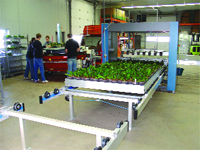 |
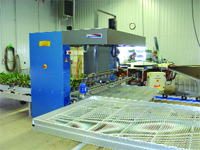
|
| The automated potting line. | |
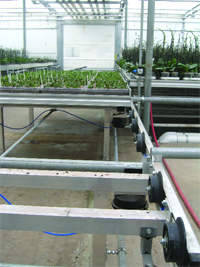 |
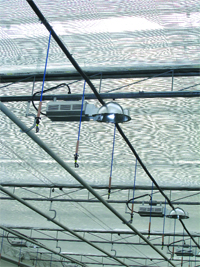 |
| An internal transport movable benching system extends throughout the 60,000-square-foot facility. | Supplemental lighting and overhead irrigation systems were part of the initial upgrades. |
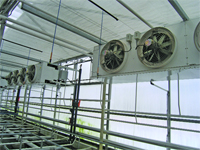 |
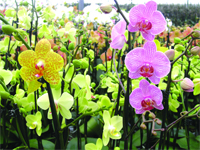
|
| Air conditioning units are essential during the crop’s cool phase, especially when outdoor temperatures reach the mid-30s C. | Ready for market. |
Print this page